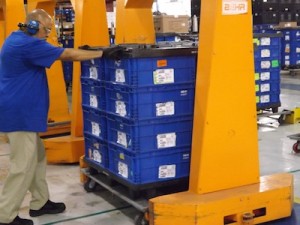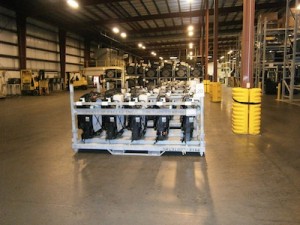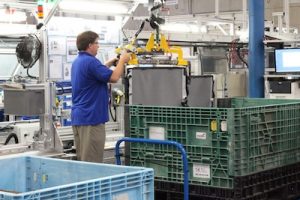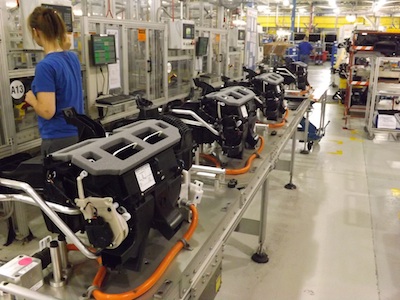Behr America is putting logistics at the heart of its North American growth, including adding new assembly processes, changing 3PLs and increasing its use of intermodal transport
With the rebound of the automotive sector in North America continuing strongly, many tier one suppliers have seen large production increases, even without adding new manufacturing capacity to their networks. This has put strain on material supply, leading some tier ones to use their global production footprints to help meet North American demand.
However, with growth in the market steady, suppliers are beginning to invest again in more plants, and with those increases comes more emphasis on improving consolidation, load density and overall transport costs in the supply chain. One such manufacturer with a growing network and a strong focus on logistics right now is Behr America, a subsidiary of the Stuttgart, Germany-based tier one supplier of cooling units for cars and trucks.
Behr, whose North American headquarters is in Troy, Michigan, has recently worked on strengthening its transport and warehousing networks, including partnering with a lead logistics provider, and switching transport modes from road to rail for a portion of its inbound freight. The company is also exploring global consolidation opportunities and lean production strategies.
The Behr Group is the 43rd largest global tier supplier, with its 2012 annual revenue about $5 billion, according to the Automotive News data centre. Earlier this
In North America, Behr has revenue in excess of $1.2 billion. It has a plant in Dayton, Ohio and one in Charleston, South Carolina, along with Mexican production in Ramos Arizpe, Coahuila, in the northeast part of the country. Martin Weiss, manager of corporate logistics for Behr America, says the company will expand its capacity in Mexico significantly by 2015, although this is still in the planning stage.
Along with its production plants, Behr has a facility in Forth Worth, Texas that provides warehousing, aftermarket service and sales, and some assembly. It also has a number of other warehouses and logistics facilities in the region.
Behr’s customers include General Motors, Ford, Chrysler, BMW, and Mercedes-Benz, as well as heavy truck makers Paccar, Freightliner, and Navistar (International Trucks).
Realigning the supply chain
Behr America has set a number of ambitious logistics targets and projects to improve its supply chain management in North America, including eliminating transport and handling damage to zero parts per million, while maintaining an inventory accuracy level of more than 99%.

The company is aiming to improve its monitoring of on-time delivery performance, including having recently rolled out a new function in its SAP system that retrieves tracking updates from its global third party logistics providers. In North America, it plans to increase its ERP connectivity with freight carriers by 2014.
It is also looking to align its supply chain along lean principles by moving to smaller lot sizes and more SKUs at the assembly line, which will impact packaging design and warehouse spaces. It has already increased its packaging density by more than 20%, by reorienting parts within packages and by nesting parts. It has increased its load density by about 20 and now has a load factor of 95%, says Weiss.
Behr has also made cost savings in packaging by using more slip-sheets – thin, pallet-sized sheets of plastic – with its own suppliers. Weiss says that slip-sheets cost only $1 compared to $10-12 each for pallets. “We have already used slip-sheets successfully on an intra-company basis. Now, we are ready for the next step,” says Weiss.
Behr has been using more slip-sheets for overseas suppliers, such as those in South Africa, and for long distance shipments within North America. Local shipments use returnable containers. Even as its use of slip-sheets increases, Weiss says Behr’s upcoming switch to rail transport could replace them and cardboard containers with returnable containers, if that works better with rail services.
Supplier developments
About 75% of Behr’s parts supplies originate in North America, with the rest from overseas, particularly from low-cost countries. Behr sources more than 50% of its parts supplies from the United States and 20% from Mexico.
Behr has consignment agreements in place with its suppliers worldwide, which delays ownership transfer until the part has been consumed at the plant or it has left the consignment warehouse within the plant. For example, consignment shipping may involve consolidating different suppliers at a 3PL’s warehouse in China. According to Weiss, this process enables Behr to ship bigger lots without increasing its inventory level, including using more full containers (FCL) and fewer less-than-container (LCL) shipments.
The company has also been renegotiating its North American shipping terms to ex-works and free carrier onboard (FCA), which enables Behr to control its  transport requirements. “We need this so that we may consolidate our freight and also ship higher transportation volumes,” explains Weiss. “These shipping terms help us to optimise our inventory carrying costs, specifically for in-transit inventory.”
transport requirements. “We need this so that we may consolidate our freight and also ship higher transportation volumes,” explains Weiss. “These shipping terms help us to optimise our inventory carrying costs, specifically for in-transit inventory.”
About 90% of Behr’s international freight is moved FCA or ex-works, with most freight consolidated into full container loads. Transport and warehousing is outsourced to Panalpina, although Behr recently put out a global freight tender. “In October, we will decide whether or not we will stay with Panalpina,” says Weiss.
The Mahle Group, which now has a majority share in Behr, also has a global freight tender underway, which will enable the two suppliers to consolidate volumes, according to Weiss. He points out that although Mahle is significantly larger than Behr, both suppliers have similar footprints, and could move more global freight together.
One of Behr’s fastest growing inbound logistics processes is North American rail transport, which will begin in the fourth quarter of this year.
“We are very close to adding rail transportation on a large scale within North America for both inbound and outbound shipments,” says Weiss. “General Motors and Ford are interested.”
Weiss points out that there is more rail momentum for inbound shipments from Behr in Mexico, or from suppliers within Mexico, which would involve switching from truck to rail and the use of a shared network.

“First, we would use rail for intra-company shipments. We expect this phase to be in place at the end of September. Then, we would use rail from our suppliers to Behr beginning next year,” reveals Weiss. In August, Behr’s rail freight tender was out to bid for shipments within the US and for shipments from Mexico to the US.
For its North American inbound parts shipments, full truckloads and milkruns account for about 80% of Behr America’s inbound shipments by weight. It receives about 35,000 truckloads annually, of which 55% originates within North America and 45% from overseas, based on freight spending. Less-than-truckload and consolidated transport accounts for about 18% of Behr’s shipments, which is typically low-volume, such as one or two-pallet shipments from remote locations. Parcel services handle 2% of its shipments, which are small parts such as nuts and bolts that move mostly by ground and sometimes by air. From overseas, Behr receives mostly full containers, some of which its freight forwarders consolidate at warehouses in Stuttgart or Shanghai.
Within North America, shipment frequency ranges from daily to weekly. The overseas shipment frequency varies, but it is normally weekly or bi-weekly. Weiss says that the company is increasing its shipping frequency by using more consolidation, shared networks and crossdocking.
In North America, Behr uses three warehouses for its inbound logistics functions. Its facility in Dayton opened in July 2013 as a Free Trade Zone (FTZ) that is also a crossdocking centre. Behr’s Charleston facility is an offsite warehouse and FTZ. In Laredo, Texas, Behr uses its border warehouse to handle consignments for its Mexican operation, which is located about 180 miles (290km) from the warehouse. Weiss says that the company is considering adding more FTZs to its network, but has not made any decisions yet.
Martin Weiss, Behr America
Behr’s warehousing system provides flat storage for raw material and high-turnover items, which are stacked two or three high on the floor. It uses shelf storage for small parts and low runners. For work-in-progress material, the warehouses use storage flow racks and floor storage for handling units. For finished goods, the warehouses offer flat storage handling unit traceability.

Although Behr outsources most of its logistics functions, it does all of its inbound material planning in-house. Some of its plants have onsite representatives from its national and international freight forwarders to maintain close communication. In September 2012, Behr made an important change with the switch of its North American 3PL from Transfreight to Protrans International, based in Indianapolis, Indiana.
“With our new provider we are using crossdocking and shared networking, through which we share warehousing facilities with Bosch,” says Weiss. “In Dayton, Protrans provides crossdocking for Behr America and several other customers.”
Behr connects its logistics network with an SAP R3 IT system and EDI with its suppliers, including a web-based EDI solution for smaller suppliers. Behr sends shipment releases and order forecasts to all of its suppliers and requests Advanced Shipping Notices (ASNs). Behr has a greater than 98% ASN accuracy rate for its in-transit shipments, with a target of 99.9%. It receives daily in-transit shipment reports for its national and international shipments, with aid from global back-office support.
“We monitor the ASN accuracy through our Behr India support centre and we address non-conformance immediately with our suppliers through the use of a quality monitoring notification. Behr uses this for supplier evaluation and charges for missing or incorrect ASNs,” says Weiss. Behr also conducts plant audits of SAP applications.
To address supply issues with lengthy lead times, such as raw materials, Behr implemented a new mid-term planning tool earlier this year that smoothes and extends customer forecasts. “If the released information is not accurate, we will adjust the forecast to the supplier manually, for lead-times of six to eight months,” says Weiss.

One of Behr’s challenges is to balance its inbound transport costs with its inventory targets and material availability. Like many other tier suppliers, Behr struggles with release fluctuations and short-term technical changes that could lead it to expedite freight or shift transport mode; the issue is typically more severe from global supply locations, including low-cost countries. “For suppliers within North America, our maximum lead-time is three days, and this is not a problem,” says Weiss.
One way that Behr addresses lead-time issues is to investigate different shipping lines and consolidation options to increase shipping frequency. However, Weiss admits that no single solution addresses this challenge; a system of efficient supply chain techniques is required, including early involvement in new project planning and implementing the ramp-up phase planning as early as possible. Behr also uses mid-term planning to ensure a high fill rate.
Behr benchmarks processes with other plants in the group and with suppliers in respect of planning, transport and material flow. Weiss says that Behr has enhanced its performance significantly and achieved considerable cost savings. “For example, overall logistics costs as a percentage of sales are lower than in previous years because of high volumes and logistics optimisation,” he reveals.
Working with customers
On the outbound side, carmakers ship mainly ex-works from Behr’s plants. Weiss notes that the shipping costs are high for its engine-cooling modules and HVAC (heating, ventilation and air conditioning) equipment because of the size of the products. “From Mexico to the midwest, it costs $15 to move one small cooling engine and $35 to move an air conditioning unit,” says Weiss.
Weiss says that there is now more of a cohesive effort between Behr and its customers to minimise total supply chain costs. For example, since Behr’s engine-cooling module consists of two components – one from each of two plants – Weiss wonders whether it would it make sense to ship one component from each plant to a satellite facility. Behr’s customers are currently evaluating the logistics costs.

Behr is also experiencing increased customer requests for sequencing and local assembly. “Our customers have increased their focus on the total supply chain cost and they require detailed cost breakdowns,” explains Weiss. “They demand local supply, assembly and sequencing. We are receiving requests for satellite assembly and ship-from points more often.”
Behr has recently implemented sequencing of its air conditioning units and engine-cooling modules for several OEMs, including Paccar. Earlier this year, Behr’s Spartanburg Sequencing Centre was also established to process its engine-cooling machines, which it assembles and sequences for BMW’s nearby plant. Multi-service provider Global Automotive Partners operates the sequencing centre.
In 2014, Behr plans to open a sequencing facility in Fairfax, Missouri, which will serve General Motors’ Fairfax assembly lant, according to Weiss. “As we consider our options, our strategy is to look for existing facilities in which to establish sequencing services, rather than build new ones,” he says.
Weiss anticipates that Behr America will intensify its partnership with logistics providers across its inbound logistics network, including in areas such as information exchange, planning, and KPI tracking. Protrans will eventually be fully integrated with Behr’s SAP planning tool, allowing it to perform short-term execution and mid-term planning.
“For example, Protrans asked us to reschedule shipments and send them a day later, which lowered our transportation costs,” says Weiss. “In this particular instance, we could save money if we decreased the shipping frequency from four times per week to three times.”
Martin Weiss, Behr America
For international logistics, Weiss expects increases in shipment consolidation when Mahle’s new contracts begin. “At Behr we are sharing our logistics network with Mahle since we are looking for more synergies and benchmarking opportunities,” he says. “In addition, we are pursuing footprint analyses for inter-company shipments, including where to buy components and at what landed cost.”
As Behr America expands its footprint in North America, logistics has been an important part of its strategy, particularly with the extension of its IT systems, increasing consolidation for North American and global shipments, and focusing supply chain design on lean principles and total cost analysis with its OEM customers. Behr’s planned shift to intermodal logistics is just one example of the type of network changes caused by the company’s growth. Weiss anticipates that the company’s logistics systems will continue to evolve.






































